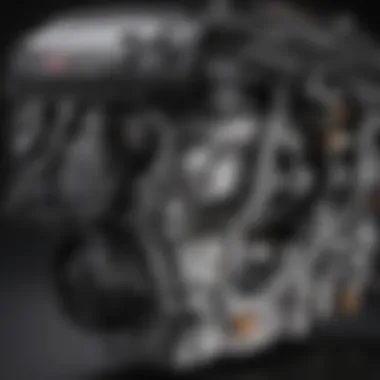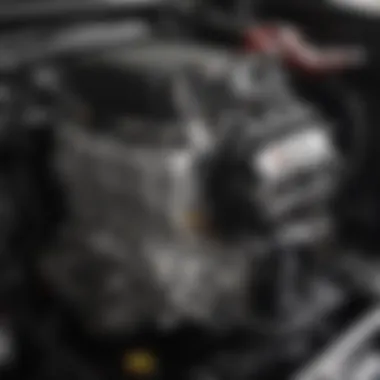Comprehensive Review of the 2007 Toyota Highlander Engine


Intro
The 2007 Toyota Highlander stands out in the automotive landscape for its balance of comfort, utility, and performance. This mid-size SUV offers a variety of attributes that attract family drivers and automotive enthusiasts alike. Understanding the specifics of its engine can help potential buyers make informed decisions, especially in a market crowded with options. In this analysis, we will rigorously explore various facets of the Highlander's engine and performance metrics, providing an in-depth perspective that goes beyond surface-level specifications.
In-Depth Vehicle Reviews
Overview of the Vehicle
The 2007 Highlander aligns itself well with the needs of daily users and adventurers. Built on Toyota's proven reliability, this model embodies the brand's dedication to providing dependable vehicles. It often serves as a family vehicle with pliable seating arrangements, claiming space not just for passengers but for their belongings too.
Key Specifications
The engine specifications of the 2007 Toyota Highlander are distinct and noteworthy. The vehicle comes equipped with either a 2.4-liter four-cylinder engine or a 3.3-liter V6 engine. The V6 engine produces an impressive 280 horsepower and delivers 248 lb-ft of torque.
- Engine Type: 2.4L I4 or 3.3L V6
- Horsepower: 280 hp in V6
- Torque: 248 lb-ft in V6
- Transmission: 5-speed automatic (standard)
Performance Analysis
When evaluating the performance of the 2007 Highlander, one must factor in both acceleration and handling. The V6 model can go from 0 to 60 mph in approximately 7.5 seconds. This rapid acceleration, paired with a smooth driving experience, positions the Highlander as a well-rounded contender in its category. The suspension setup provides needed comfort on long journeys while still offering stability on winding roads.
Safety Features
Safety is paramount for family-oriented SUVs, and Toyota has implemented various systems to secure passengers in the 2007 Highlander. Features include stability control, traction control, and regularly healthy crash test ratings, contributing to its reputation as a reliable family vehicle.
Technology and Infotainment
The tech package in the 2007 Highlander includes optional upgrades like a JBL audio system and navigation features. Although not as advanced as the most modern vehicles, these features still enhance the driving experience, proving useful during travels and daily commutes.
Fuel Efficiency and Sustainability
Fuel efficiency is a crucial aspect for SUV buyers, and the Highlander's performance on this front is commendable. The fuel economy remains at around 20 miles per gallon in the city and 26 mpg on the highway for the V6 engine. These figures compare favorably within its class, which further solidifies its positioning among buyers.
The 2007 Toyota Highlander's 3.3L V6 engine balances powerful performance with reliable fuel efficiency, making it an appealing choice for drivers.
Head-to-Head Comparisons
Comparison Criteria
When analyzing the 2007 Highlander against its competitors, factors like engine performance, safety ratings, and fuel economy are crucial. By looking into multiple angles, we can further enhance buyer knowledge.
Detailed Model Comparison
When pitted against contemporaneous models such as the Honda Pilot and Ford Edge, the Highlander showcases strengths in various domains. Honda's model provides excellent cargo space, while Ford gives a more powerful engine option. Customer preferences usually tip toward handling and balance, qualities embodied well by the Highlander.
Visual Representation (Tables/Charts)
While specific tables cannot be shown here, it's helpful to consider data side-by-side. That method could enhance understanding and decision-making.
Pros and Cons of Each Model
- Toyota Highlander
Pros: Reliable engine, good safety ratings, efficient fuel consumption.
Cons: Lacks advanced tech compared to newer models. - Honda Pilot
Pros: Spacious interior, excellent safety features.
Cons: Less fuel-efficient than Highlander. - Ford Edge
Pros: Sporty handling, attractive styling.
Cons: Limited third-row space.
Price Comparison and Value Assessment
The price point for the 2007 Toyota Highlander typically fits into an affordable range, particularly when viewed against Honda and Ford models. Buyers should consider used options available in the market to gauge overall value for their needs.
Buying Advice and Recommendations
Factors to Consider Before Purchasing
Before settling on the 2007 Highlander, buyers should deliberate budget and intended use. Family size, driving habits, and desired features are essential to evaluate.
Best Practices for Test Driving
Engaging in a test drive is instrumental in assessing comfort and drivability. Familiarize yourself with road performance and included features during the trial.
Financing and Insurance Tips
In securing financing, several reputable options exist. Dish lighter or maximize loan amounts linked to favorable interest rates. With insurance, explore multiple providers to secure the best rate.
Top Recommendations Based on Lifestyle Needs


Buyers should identify lifestyle matching with their vehicular needs. For safety features, commuting needs, and overall comfort; likely, the Highlander will satisfy the core principles.
Checklist for First-Time Buyers
- Establish a budget.
- Review Highlander’s key features.
- Conduct thorough research on market prices.
- Test drive multiple competitors.
Market Trends and Insights
Current Automotive Trends
The automotive market advances notion rapidly. Increased demands for family SUVs reverberate through customer bases; with a priority toward safety, comfort, and dependability.
Emerging Technologies
Technological trends indicate significant movement toward embracing hybrid and electric options. Transportation is progressively prioritizing reduced environmental impact.
Electric and Hybrid Vehicle Developments
Recent applicable milestones have pushed these types substantially into market entry. As these models become more prominent, traditional gasoline-powered vehicles face scrutiny over longevity.
Consumer Preferences and Psychological Factors
Consumers increasingly desire vehicles that project safety, reliability, and sustainability, leading to market shifts. This change shows promise as evidenced through retail enthusiasm.
Impact of Global Events on Automotive Sales
Broad occurrences, like economic fluctuations, influence sales dynamics. Shocks can lead to reduced market spending, impacting models directly like the Highlander.
Maintenance and Ownership Costs
Overview of Regular Maintenance Needs
Buying any vehicle creates an obligation toward ongoing care and diverse repairs. Common needs include prescribed oil changes, tire rotations, and brake checks.
Long-Term Ownership Costs
While the Highlander usually boasts reliability, it is wise to anticipate eventual replacements of critical components, including brake pads and tires.
Tips for Reducing Maintenance Expenses
Being proactive contributes to finance management. Regular preventive check-ups keep the vehicle at its best and circumvent unanticipated costs.
Comparison of Warranty Options
Like in many used vehicles, existing warranties vary from upheld standards to coverage from new ownership. Familiarizing with found expectations helps gauge applicable choices.
Real Owner Experiences and Cost Experiences
Feedback from existing Highlander owners indicates a balanced view regarding repair history and costs associated. General sentiment points toward a highly favorable finish regarding total ownership experience avoiding severe falters.
Overview of the Toyota Highlander
The 2007 Toyota Highlander presents an important chapter in the evolution of mid-size SUVs. Understanding this model involves examining its overall functionality, design, and core features. The Highlander occupies a unique space in the market, often appealing to families and those seeking versatility with an extra touch of comfort. This overview establishes a framework that highlights both its appeal and how it matches user expectations.
General Specifications
The core of the Highlander’s appeal can be tied back to its specifications. These include the engine options, drivetrain choices, and overall dimensions.
- Engine Options: The main offerings consist of a V6 engine that is renowned for its power and reliability, providing a balance suitable for both city commuting and highway travel.
- Drivetrain: Customers have the choice between front-wheel drive and all-wheel drive, allowing for flexibility in handling varying road conditions.
- Dimensions: The size is particularly notable. With a spacious interior, the Highlander accommodates up to seven passengers comfortably, which proves essential for larger families or groups.
The general specifications set the stage for why the 2007 Toyota Highlander remains a suitable candidate for consideration among avid SUV consumers.
Market Positioning and Target Audience
Positioning within the market is equally critical. The 2007 Highlander serves a specific demographic that seeks more than just utilitarian design. It is designed for blended purposes, be it utility, family travel, or easy commuting. There are several factors underpinning its targeted audience.
- Family-Oriented Buyers: Families appreciate its size and capacity for connecting child safety systems, encountering little validation.
- Active Lifestyles: Social activities or leisure travels position this SUV advantageously among outdoor enthusiasts who desire sufficient cargo space for sporting gear or other equipment.
- Mid-Range Budget Sectors: By meeting the economic requirements for professional mid-lifers and equipped with necessary features, it secures its mark, particularly in suburban class.
The positioning evokes genuine interest from the right buyers; hence, discerning its market role enhances understanding for potential purchasers as informed insights into the integrating extensive factors that make Toyota Highlander stand prominently.
Engine Specifications


Engine specifications are fundamental in understanding the operational capabilities of the 2007 Toyota Highlander. They define how well the vehicle performs in various situations and indicate the suitability of the engine for different driving needs. Knowing the specifications helps potential buyers make informed choices about performance, reliability, and efficiency. Furthermore, understanding these aspects is essential for automotive enthusiasts, as they delve deeper into the technical attributes that set this vehicle apart from its competitors.
Available Engine Types
In the 2007 Toyota Highlander, two engine options were available to cater to varying driver needs and preferences. The primary engine was a 3.3-liter V6 engine, known for its balance between power and fuel economy. This engine produced a robust performance suitable for daily driving and light towing tasks. An alternatively available option was a hybrid version, specifically designed to enhance fuel efficiency while maintaining respectable power.
Key Engine Types
- 3.3-liter V6 Engine: This engine provided a good blend of power and efficiency.
- Hybrid Engine: It offered an eco-friendly option for those looking to reduce fuel consumption.
These engine types allowed Toyota to target a diverse group of consumers. Families seeking utility valued the V6, while environmentally conscious buyers appreciated the hybrid variant.
Engine Displacement and Configuration
The combination of engine displacement and configuration plays a crucial role in determining the vehicle's overall performance. The 3.3-liter V6 engine had a V-type configuration, which allowed for smoother operation and enhanced performance over straight engines. With a displacement of about 3,319 cubic centimeters, this engine delivered a significant amount of power for a mid-size SUV.
Additionally, its design promoted good torque delivery, making acceleration more responsive. The ability to provide adequate power without sacrificing efficiency is a noteworthy accomplishment marked by this particular engine configuration.
Horsepower and Torque Ratings
Engine power is often measured in horsepower and torque, both of which are critical metrics for understanding an engine’s capability. In the case of the Highlander’s 3.3-liter V6 engine, the horsepower rating was around 245 hp at 6,000 rpm. Meanwhile, the torque output reached a solid 242 lb-ft at 3,600 rpm.
This configuration allowed the Highlander to effectively manage highway driving, while still providing a unified driving experience for both city and suburban settings. In simple terms, these ratings indicated brisk acceleration when merging onto highways and an adequately powerful response during passing maneuvers.
Understanding these engine specifications is vital for anyone considering the 2007 Toyota Highlander, as they ultimately determine how the vehicle fits into an individual's driving lifestyle.
In summary, engine specifications define the core characteristics of the 2007 Toyota Highlander. By dissecting the available engine types, analyzing the academic details of displacement and configuration, as well as evaluating horsepower and torque ratings, one can gain a fuller perspective of what this SUV offers, positioning it effectively in a diverse automotive market.
Performance Metrics
Understanding the performance metrics of the 2007 Toyota Highlander is central to evaluating its overall value and capability as a mid-size SUV. Performance metrics encompass key elements that affect how the vehicle drives and feels on the road. They are critical benchmarks that not only signify how well a car can perform under various conditions but also inform potential buyers on what to expect in terms of day-to-day usability and efficiency.
Through precise measurement of acceleration, speed, fuel efficiency, and driving comfort, automotive enthusiasts can better grasp whether the Highlander aligns with their driving expectations and requirements.
Acceleration and Speed
The 2007 Toyota Highlander comes with two engine options: a 2.4-liter four-cylinder and a 3.3-liter V6, the latter being the more powerful of the two. Acceleration is an essential performance metric because it indicates how quickly a vehicle can gain speed from a full stop. The 3.3-liter V6 in the Highlander moves from 0 to 60 mph in approximately 7.5 seconds, a competitive figure for its class. This engine offers not just linear acceleration but also sufficient punch for merging on highways.
Performance in speed is notably consistent with the Highlander's engine compatibility. With a top speed nearing 130 mph, it allows for safe highway driving and complying with speed limits under various conditions. Zero to sixty performance is satisfactory but is bettered by sportier SUVs. Nevertheless, the ratings presented frame the Highlander as a versatile choice among family-oriented SUVs.
Fuel Efficiency Ratings
Fuel efficiency is a major consideration for many buyers, especially with ongoing fluctuations in gas prices. The 2007 Toyota Highlander with the four-cylinder engine averages about 20 mpg in the city and 27 mpg on the highway. In contrast, the V6 engine provides slightly lower numbers, averaging around 18 mpg in the city and 24 mpg on the highway. While not the benchmark in this category, it offers reasonable efficiency, especially for spacious mid-size SUVs.
Furthermore, the combination of fuel tank capacity at around 19.8 gallons means that owners can expect a commendable driving range before requiring refueling. Generally, those prioritizing fuel efficiency may prefer the four-cylinder option. Past consumer reviews indicate satisfaction with the Highlander’s performance which allows it to meet the demands of daily commuting or road trips with relative ease.
Handling and Ride Quality
Handling and ride quality are integral metrics contributing to the overall driving experience. The Highlander's suspension is designed for comfort, providing a smooth ride on various terrains. Thanks to its meticulously engineered configurations, the vehicle demonstrates a balanced ride by absorbing road irregularities effectively.
Through standard features, like a front-independent suspension combined with a rear stabilizer bar, the Highlander assures secure handling when navigating turns, making it a practical choice for families or individuals prone to long drives. Feedback from review boards suggests that the handling is not sport-tuned; however, it does engender a sense of stability while driving at highway speeds. This ensures that the Highlander remains engaging to drive while emphasizing passenger comfort.
The 2007 Toyota Highlander's performance metrics make it an effective contender in the mid-size SUV category by balancing the blend of acceleration, fuel efficiency, and ride quality suitable for various driving needs.
Engine Technology and Features
Understanding the engine technology and features of the 2007 Toyota Highlander is crucial for both enthusiasts and potential buyers. Not only do they represent the current state of automotive engineering, but they also determine efficiency, reliability, and performance characterstics. A closer look at the specific aspects of this technology reveals its role in shaping the driving experience.
Fuel Injection Technology
The fuel injection system of the 2007 Highlander plays a vital part in its overall performance. This model employs a multi-point fuel injection system, which delivers fuel directly into each cylinder. This design is significant for several reasons:
- Improved Fuel Efficiency: By controlling the fuel-air mixture more accurately, the engine can maximize combustion efficiency and translate that into better mileage.
- Enhanced Performance: The system allows for quicker throttle response, crucial for city driving conditions.
- Reduced Emissions: Improved fuel burning means less waste, which is increasingly important given today’s environmental standards.
Emissions Control Systems
The Highlander is equipped with several emissions control systems aiming to meet stringent regulatory requirements. The significance of these features cannot be understated:
- Catalytic Converter: This unit converts harmful exhaust gases into less harmful emissions, helping the vehicle comply with EPA regulations.
- Evaporative Emission Control: This system minimizes fuel vapors from escaping into the atmosphere. It effectively channels these vapors back into the intake manifold for combustion.
- Onboard Diagnostic System (OBD-II): This system monitors emissions in real-time, alerting the driver to any potential faults or required maintenance. This nondisruptive overview promotes higher performance in responsively controlled environments.
Common Rail Diesel Technology


While the 2007 Toyota Highlander primarily features gas engines, it's important to note the advancements in diesel technology relevant to the SUV market. Common rail diesel technology allows for better control over fuel delivery for diesel engines:
- Precision: The common rail system generates high pressure, making it feasible to inject fuel multiple times during each cycle. This precision leads to smoother operation.
- Torque: Diesel engines often yield greater torque, beneficial for towing and heavy loads, which aligns with consumer interest in the Highlander as a family utility vehicle.
- Higher Efficiency: Implementations of diesel technology can often yield better fuel economy figures.
In summary, the Toyota Highlander's 2007 engine technology not only adheres to necessary regulatory standards but also enhances the driving capabilities of the midsize SUV, appealing to both eco-conscious and performance-oriented consumers. By understanding these intricate systems, potential buyers can make more informed choices about their driving legacy.
Reliability and Maintenance
Reliability and maintenance are crucial for evaluating any vehicle, especially for the 2007 Toyota Highlander. Understanding these elements informs potential buyers and current owners about the vehicle's dependability, longevity, and upkeep requirements. An overview of reliability incorporates the engine's performance consistency over time and the frequency of mechanical problems. On the maintenance side, regular practice ensures the vehicle sustains its efficiency and reduces long-term costs.
Common Engine Issues
The engine of the 2007 Toyota Highlander, while generally reliable, has a set of common issues reported by users. A few noteworthy concerns include coolant leaks, which stem from faulty radiator components, and oil consumption that may arise when the vehicle has substantial mileage. Additionally, abnormal noises could indicate more serious underlying issues. Regularly checking the vehicle will often catch these problems early, mitigating further expenses.
- Coolant leaks are particularly frustrating. Not only can this lead to overheating, but it also often necessitates expensive repairs if not addressed promptly.
- Oil consumption manifests not just from regular use; it can also be indicative of wear in critical engine components.
Always keep an ear out for unusual sounds from the engine. Timely detection often leads to simpler, cheaper solutions.
Regular Maintenance Practices
Routine maintenance goes a long way in ensuring the Highlander's engine remains in good health. Simple practices include regular oil changes, checking the coolant levels, and changing air filters when needed. A maintenance schedule may look something like this:
- Oil Change: Every 5,000 to 7,500 miles for optimal performance.
- Air Filter Check: At least once a year to ensure proper airflow.
- Coolant Level Check: Regularly visualize and ensure there is adequate coolant to forestall overheating.
Staying on top of these tasks can enhance the reliability of the 2007 Highlander engine, leading to a seamless driving experience over the years.
Warranty and Service History
When assessing the reliability of the Highlander, it's wise to consider its warranty and service history. The original warranty for the 2007 Highlander typically covered powertrain components for at least five years/60,000 miles, with a basic warranty of three years/36,000 miles. Checking with previous owners or service records can show how well the vehicle was maintained. A strong service history signals that prior owners took care of engine health through regular check-ups and repairs. It can also give insight into whether any major engine issues are already remedied or persist unresolved.
By gathering this information, potential buyers get a clearer picture of expectations regarding reliability and future maintenance. Quality research into warranties and a thorough service history will pave the way for informed purchasing and ownership decisions.
Comparative Analysis
Taking a comparative approach to understanding the 2007 Toyota Highlander's engine provides essential insights for potential buyers and enthusiasts. By examining differences and similarities between the Highlander's engine and those of adjacent model years alongside its competitors, it becomes easier to pinpoint strengths and weaknesses. This analysis highlights the evolution of technology, helps discern market positioning, and offers information on performance expectations that may guide purchasing decisions.
Comparison with and Models
When looking specifically at the engine offerings from the Highlander in 2006, 2007, and 2008, some notable differences emerge. While the 2006 model spotlighted a 3.3-liter V6 engine producing 215 horsepower, the 2007 upgrade introduced a slightly enhanced 3.5-liter V6 engine, which increased power to around 270 horsepower. The additional torque measured up to 248 lb-ft from 213 lb-ft, improving overall performance dramatically.
The 2008 model retained the same engine, yet introduced slight tweaks to boost fuel efficiency, notably through optimizations within the engine’s management system. This consistency can have implications for long-term reliability as well.
Here are some key points capturing this comparison:
- 2006 Model: 3.3L V6, 215 hp, 213 lb-ft torque
- 2007 Model: 3.5L V6, 270 hp, 248 lb-ft torque
- 2008 Model: 3.5L V6, efficiency adjustments, similar specifications
Each year brought improvements in output and efficiency, indicating Toyota’s commitment to continual engine development to cater to changing consumer demands.
Benchmarking Against Competitors
In assessing the 2007 Highlander's engine, its performance benchmarks against contemporaries like the Honda Pilot and Ford Edge are critical. The Honda Pilot also featured a V6 engine, generally rated around 251 horsepower, but the torque figures can be a point of consideration as the Pilot offered similar performance attributes.
However, the Highlander excelled in fuel economy thanks to enhanced flow within its 3.5-liter engine design. With demonstrated ratings of up to 22 mpg combined, it easily outperformed competitors in this area. Benchmarking other similar models brings forth some important advantages of the Highlander as follows:
- Power Output: Highlander slightly exceeds Honda Pilot with 270 hp versus 251 hp.
- Fuel Efficiency: Enhanced systems aimed to yield commendable ratings compared to competing models.
- Reliability Ratings: The Toyota brand frequently scores higher in consumer reliability surveys.
Thus, through comparative analysis, potential buyers can better assess the 2007 Toyota Highlander's engine against both contemporaries and previous models as it makes a compelling argument for performance, safety, and overall value in the increasingly competitive SUV market.
Final Thoughts
The exploration of the 2007 Toyota Highlander engine reveals a variety of essential insights, focusing on its configurations, performance, and reliability. This culminates in a robust understanding of the vehicle as a whole. Final thoughts serve as a synthesis of this information, underpinning what the 2007 Highlander represents in the competitive mid-size SUV market.
In considering the engine specifications and performance metrics, one recognizes crucial elements that reflect on the Highlander’s overall offering. This model stood the test of time due in part to its balance of power and efficiency, catering to families and individual buyers alike.
The Highlander provides an avenue for automotive enthusiasts and practical users to coexist in a single, versatile package.
Summation of Key Findings
Upon review, several core findings become apparent:
- Engine Features: The 2007 Highlander is equipped with options for V6 engines that effectively blend performance with fuel efficiency.
- Performance Metrics: Notable acceleration and speed figures place it well among its contemporaries, demonstrating its capability on the road.
- Reliability Discussion: While beneficial in various respects, issues around regular maintenance must be noted as a consideration for owners.
These observations highlight the Highlander’s strengths while simultaneously guiding potential buyers on what to expect concerning performance and reliability.
Considerations for Potential Buyers
Potential buyers need to weigh specific factors educationally before making decisions:
- Usage Requirements: Determine if the Highlander’s size and engine capacity meet long-term needs, such as family trips, daily commutes, or both.
- Maintenance Awareness: Having knowledge of common engine issues can preemptively field frustration after purchase and save time and money.
- Market Comparison: A comparative analysis against equivalent models can support informed decision-making, allowing for critical assessment of features and performance nuances.
- Test Driving: Engaging firsthand with the vehicle enables an appreciation for the nuanced handling and ride quality offered by this model.















